
Growing Potatoes: Requirements, Conditions, And Techniques
Growing potatoes has great revenue potential, but producing high-quality tubers on a large scale poses specific challenges. From pre-planting to harvesting, the process of growing potatoes requires close attention to crop requirements and mastering the whole growth cycle using innovative techniques to gain a competitive edge. Precision agriculture systems aid in potato planting, irrigation, and fertilizer application, while GPS-guided agriculture machinery eliminates overlapping and speeds up field activities. Combining this with integrated weed and pest management, regular plant hilling, and gentle machine harvesting, farms can achieve better yields and higher profits.
Potato Varieties At A Glance
Potatoes (Solanum tuberosum) are more commonly cultivated in the summer in colder growing regions, but they can also be cultivated as winter crops in warmer regions. Crop cultivars vary in multiple parameters, including tuber shape, flesh color and structure, and skin color.
Considerations like intended applications, storage strategies, and harvesting dates should guide commercial producers when selecting a potato variety to grow. The following are groups of varieties depending on when the crop is harvested:
- early-season: Irish Cobbler, Red Norland, Purple Majesty, Mountain Rose;
- mid-season: Yukon Gold, Austrian Crescent, Red Pontiac, Viking, Chieftan;
- late-season: Katahdin, Elba, German Butterball, Kennebec, French Fingerling.
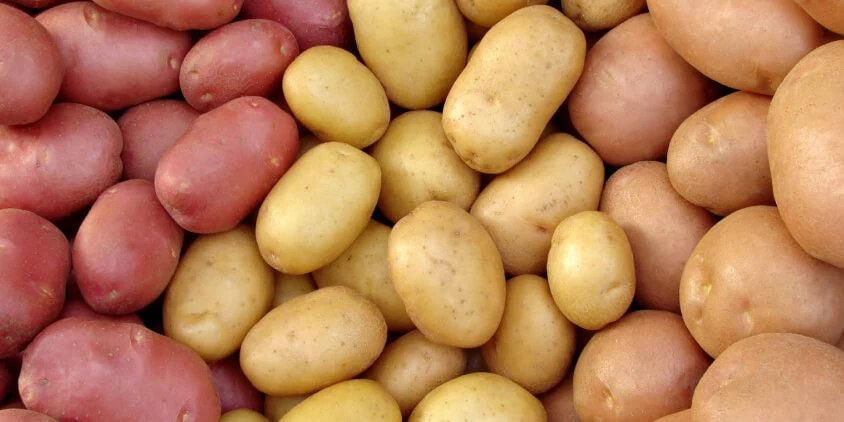
Favorable Potato Growing Conditions
Even in less-than-ideal growing conditions, plants can produce a respectable yield. Still, choosing a field with favorable growing conditions from the start will help the farmer save time and resources.
Soil Requirements For Growing Potatoes
While potatoes grow in different soils, the best one is sandy loam or another type of loose, well-drained soil rich in nutrients. It may be necessary to irrigate plants growing in sandy soils more frequently to keep them adequately moist. Misshapen tubers can grow in poorly drained soils that have a fine texture and a high concentration of clay and silt.
The crop grows well in neutral soils with a pH of 5.5 to 6.0. More alkaline soils have a higher prevalence of common scab, a tuber-affecting soil-borne disease. It’s recommended to get your soil tested before planting crops. This way, you’ll know if the soil is already suitable for planting potatoes or if it needs any amendments.
Temperature And Sun Requirements For Growing Potatoes
Optimal potato growing temperatures range from 65–80°F (18–29°C) during the day to 55–65°F (13–18°C) at night. At least six hours of sunlight every day are needed for crops to grow well. Though they prefer direct sunlight, potatoes may also grow in a dappled shade. However, the yield drops and the tubers get smaller as a result of growing in a dappled shade.
EOSDA Crop Monitoring makes it simple to keep tabs on the weather in your fields. You can acquire field-specific temperature data, both historical and forecast. Use historical data as far back as 1979 for pre-planting analysis to determine if the field is suited for growing potatoes commercially. Rely on a 14-day forecast for flexible planning and scheduling of your field operations.
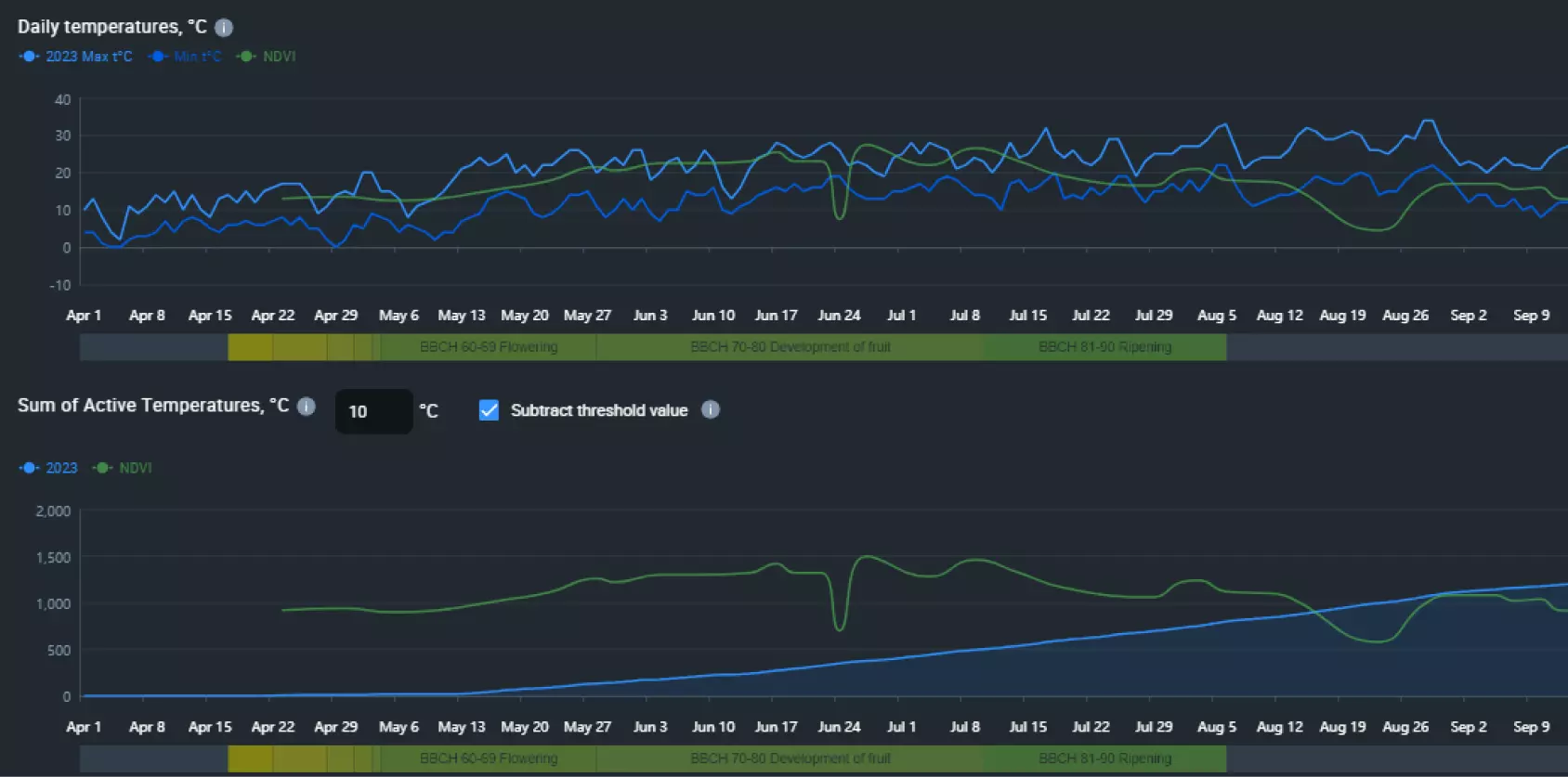
Potato Pre-Planting Process
Before planting potatoes, you should prepare the seeding material and process the soil. It was formerly thought that this crop required the highest level of tillage and could not be grown with zero or minimum tillage. However, current farming practices have proven that minimum tillage is effective for growing the crop and provides many benefits.
Preparing Seed Potatoes For Planting
Seed potatoes are tubers for planting, specially selected and prepared. Cutting potatoes is a common planting preparation procedure. The tiny sprouts on the pieces, also known as eyes, are the starting point for the plant’s stems and roots. The plants grow quickly from the very beginning, thanks to the energy stored in the seed pieces.
Cutting the seeds to the same size is a critical step in achieving planting uniformity. That way, the plants in the field will all grow to a similar size, allowing farmers to harvest more tubers per unit of land without sacrificing yield consistency. To keep rot-causing bacteria and fungus growing on potatoes at bay, it is typical practice to apply seed treatment to cut pieces.
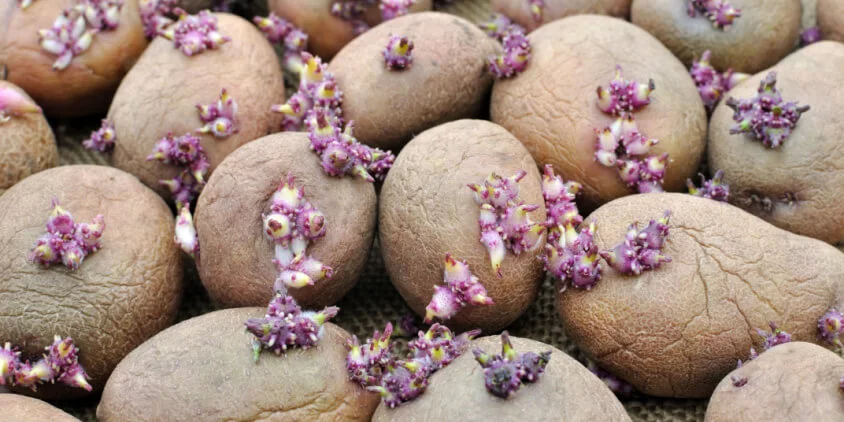
Soil Preparation
The soil after brassicas, which loosen it, provides favorable conditions for potatoes to grow. To lessen the chances of spreading disease-causing germs or viruses, avoid growing potatoes in a field that has already been planted with other crops in the Solanaceae family.
Conventional soil preparation procedures involve tilling the soil 8–10 inches (20–31 cm) deep and applying 3–4 inches (8–10 cm) of organic fertilizer or compost four to six weeks before planting. For fields with clayey soil or poor drainage, raised beds may be the way to go. Before planting potatoes, make sure the bed is level by raking away any rocks and debris.
Although relatively few potato farmers are now adopting minimum tillage, many are already making progress toward this approach through cover cropping. The farmers who grow the crop using minimum tillage techniques are sure that this method reduces disease pressure and increases the soil’s ability to store water .
EOSDA Crop Monitoring
Fields monitoring platform, leveraging high-resolution satellite images to identify and react to any changes remotely!
Planting Potatoes
The potato growing season begins in the spring, about 2–4 weeks after the last frost. Plant seed potatoes in soil with a temperature of at least 45°F (7°C). Cold soil, whether wet or dry, is always a source of concern: wet soil increases the risk of rotting seed pieces, whereas dry soil slows germination and seedling emergence.
For best results, a potato planting depth of 2–3 inches (6–8 cm) is optimal in most soils, but you can go as deep as 4 inches (10 cm) in sandy soils. For medium-sized types, the recommended spacing between rows is 30 to 36 inches (76 to 91 cm), and the seed pieces should be 9 to 12 inches (22 to 30 cm) apart inside each row. While broader potato planting spacing does produce larger tubers overall, it might cause developmental defects like hollow hearts in certain varieties, such as Yukon Gold. To ensure uniform planting and straight rows, many farmers harness GPS and GIS agricultural technologies.
Potato growing season typically begins in the spring months. Early to mid-April is the typical planting time for early varieties in colder growing regions. The planting season often spans from September to February in warmer growing regions.
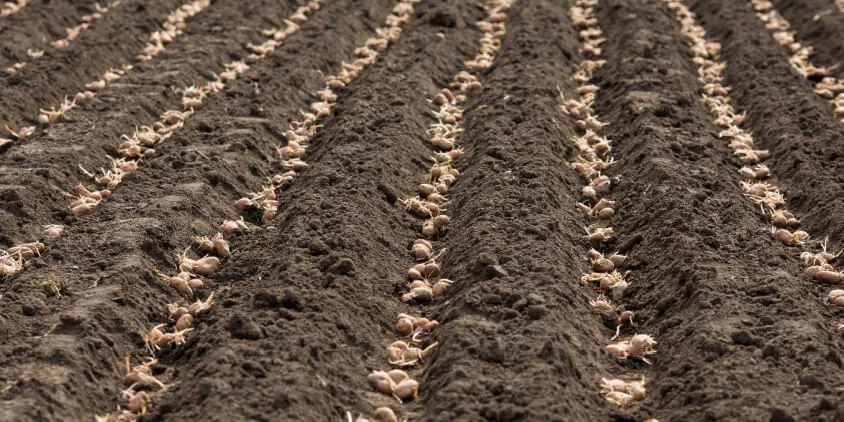
Care For Growing Potato Plants
A healthy plant is essential for a good yield. By focusing on proper maintenance practices throughout the potato growing season, you can ensure robust growth, minimize the risk of diseases, and maximize the yield of high-quality tubers.
Consistent Watering
To grow high-quality tubers, you need to maintain consistent and adequate soil moisture levels. It is of utmost importance to preserve uniform hydration across the root zone without allowing it to become too wet, especially after the flowering stage.
One inch (25 mm) of water each week is more than enough on most soils. On sandy, organic-matter-poor soils, though, up to two inches (50 mm) per week could be necessary.
Growth cracks, internal spotting, and hollow hearts are disorders that tubers growing in soil that swings from dry to moist could develop. The tubers could end up looking crooked if you water potatoes too much immediately after planting or not enough when they start to grow actively. Low tuber quantity and quality can result from prolonged exposure to high moisture levels, especially when harvest time approaches. If the leaves start to wilt and die, you should stop watering right away.
Using remote crop monitoring solutions, commercial growers may get soil moisture data from both the surface and the root zone. By using this information, you may thoroughly examine large-scale potato growing fields, recognize signs of inadequate moisture, and develop specific, localized solutions to ensure plant health and maximum output. Since the moisture demand varies from one stage of plant growth to another, the platform’s capability to provide information on the current growth stage based on the sowing date is particularly helpful for potato producers.
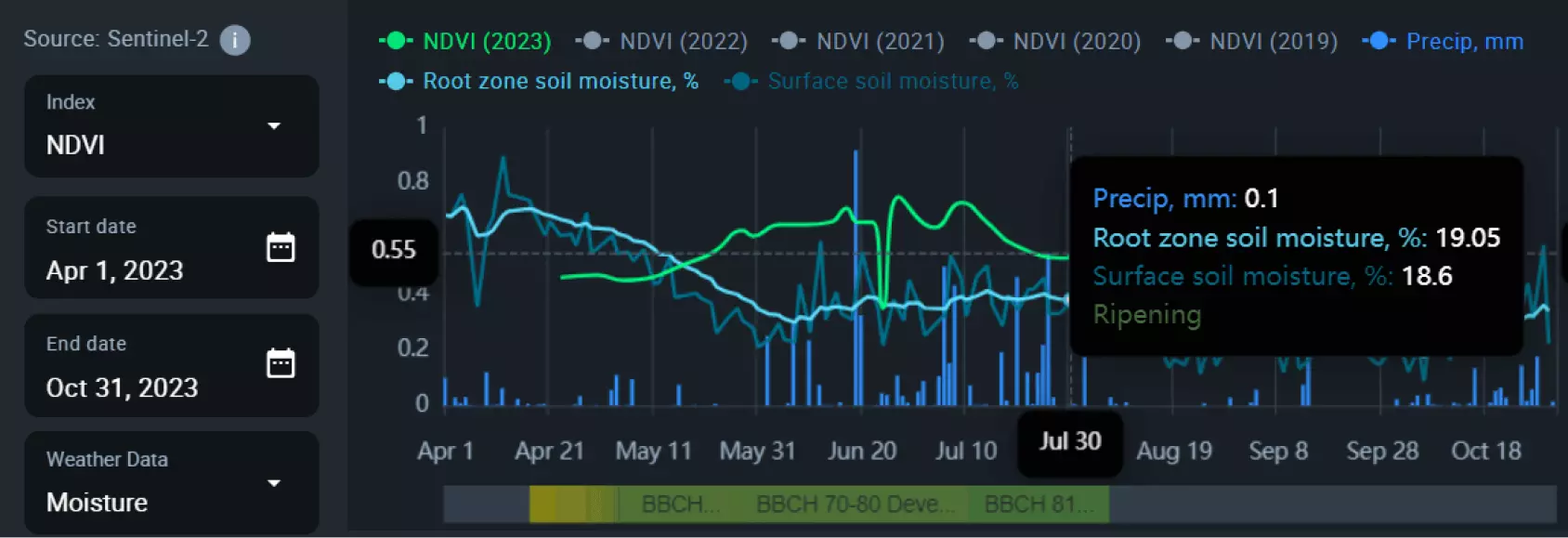
Adequate Fertilizing
For optimal potato growth, choose a fertilizer type that is heavier in phosphorus (P) and potassium (K) and lighter in nitrogen (N). A suitable NPK fertilizer ratio would be 5-10-10, or any other with P and K amounts double the N amount. The plant needs potassium and phosphorus to grow healthy tubers, but too much nitrogen will make it put out too many leaves, which is bad for a root crop. Besides, if growing plants get too much nitrogen, they may become more sensitive to diseases like late blight.
The conventional method for applying slow-release granular fertilizers to growing potatoes involves digging shallow ditches adjacent to the crops, scattering the feeding mix, and then covering it with some dirt. Spreading water-soluble, fast-release fertilizers through fertigation systems requires caution to avoid soaking the leaves. Additionally, crops can be fed organically with wood ash, seaweed, chicken manure, or bone meal.
When planning your fertilization program, consider using EOSDA Crop Monitoring’s satellite-based vegetation maps. These maps provide valuable insights through the accurate identification of potentially low- to high-productivity areas by distinguishing between zones with abundant or sparse vegetation. If the algorithm reveals abnormally low vegetation in some areas, it could be a telltale sign of nitrogen deficiency, which hinders the growth of plant leaves and, consequently, the root crop. In this area, extra nitrogen fertilizers might be beneficial for growing plants.
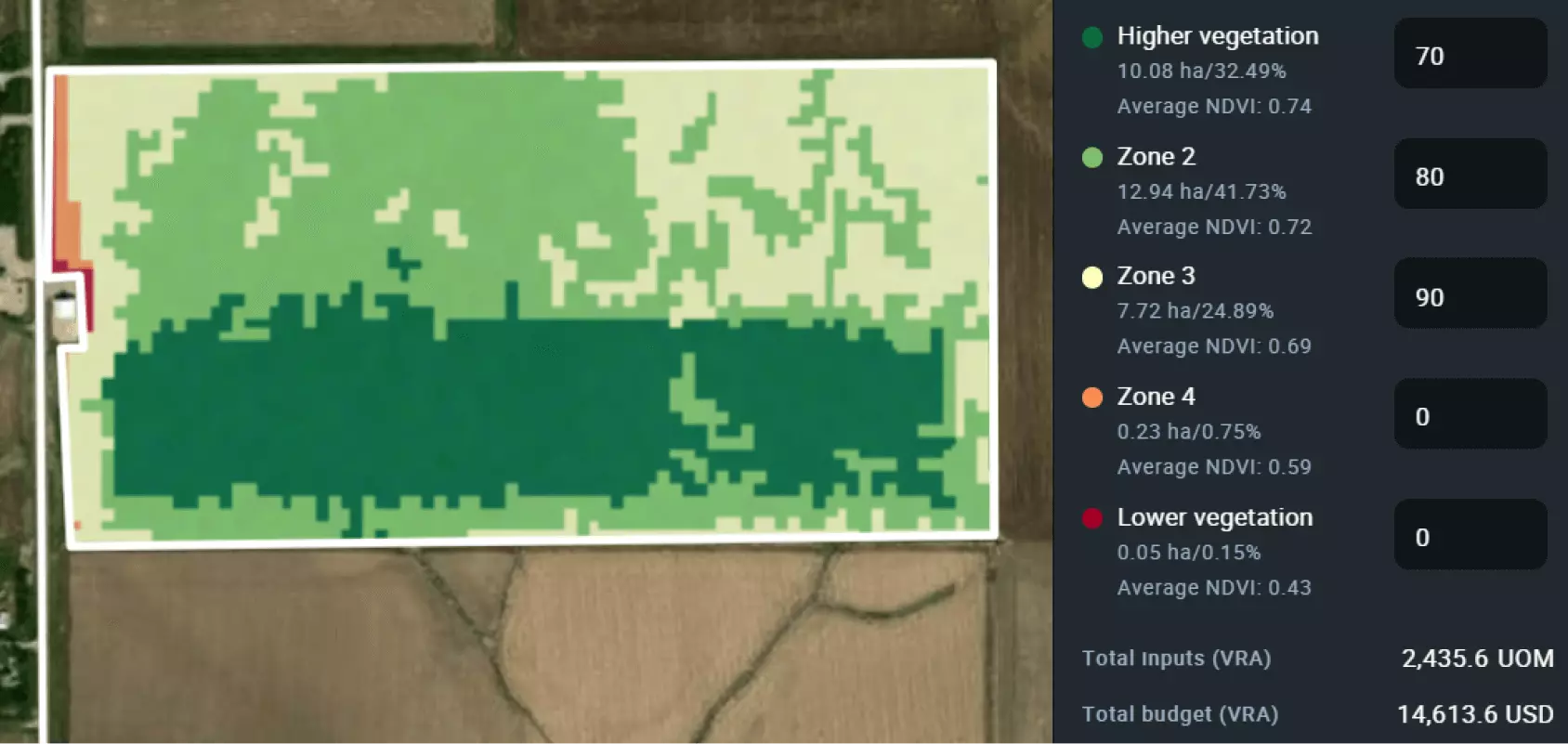
Regular Hilling
The agronomic practice of hilling is essential for improving both tuber yield and quality. Hilling protects tubers from direct sunlight, preventing them from turning green. After the green shoots grow to a height of 8 inches (20 cm), cover them with soil, shredded leaves or straw, leaving only the top 4 inches (10 cm) exposed. It’s time to hill the potatoes again when they grow by another 8 inches (20 cm). More frequent hilling usually results in growing a bountier crop. When the vines bloom, it’s about to stop hilling.
Timely Weed, Pest, And Disease Management
Weeds, along with competing for resources with growing potatoes, serve as hosts for diseases and pests. Different weeds pose risks in different growing regions, but weed management approaches are generally the same. Shallow cultivation is a good method to start with. To avoid damaging tubers in the late growing season, pick weeds by hand rather than hoeing them. Mulches can also prevent weeds from growing while keeping the soil moist.
The plants’ leaves are a window into many of the issues caused by pests and diseases. Let’s take a look at the most common disorders and how they manifest themselves so that you can pinpoint the source of your problem and devise an appropriate treatment strategy to avoid potato growing problems.
| Cause | Symptom |
|---|---|
| Rhizoctonia | Reddish-brown rot or lesions seen on the sprouts and stolons |
| Bacterial soft rot and blackleg | Black and wet stem rot stem, primarily at ground level |
| Leaf‐roll virus | Slowed crop growth, yellow or pale green leaf coloration, and inward curling of lower leaves |
| Early blight | Tiny, black or dark brown lesions having concentric rings |
| Late blight | Dark, soaked patches on stems and leaves |
| Nitrogen deficiency | Lower leaf yellowing and early leaf drop |
| Colorado potato beetle | Leaf and petiole defoliation; larvae, beetles, and/or masses of orange eggs seen on the lower part of leaves |
| Potato leafhopper or cabbage looper | Jagged holes, dried brown margins, and inward curling of leaves |
Numerous pests can eat into your growing crop, reducing its total productivity. That’s why it is critical to keep an eye on pest population growth and intervene when needed. However, regular, thorough in-field inspections are feasible on a small scale but not on a large scale.
The features of EOSDA Crop Monitoring come into play here. They allow you to monitor vegetation anomalies in any potato growing field, no matter how remote, and respond swiftly by sending scouts to check only problem areas. Use EOSDA Crop Monitoring to delegate tasks to scouts, such as determining the type of pest and taking photos of damaged plants by a certain date, and then collect comprehensive reports from all of your fields in one convenient spot.
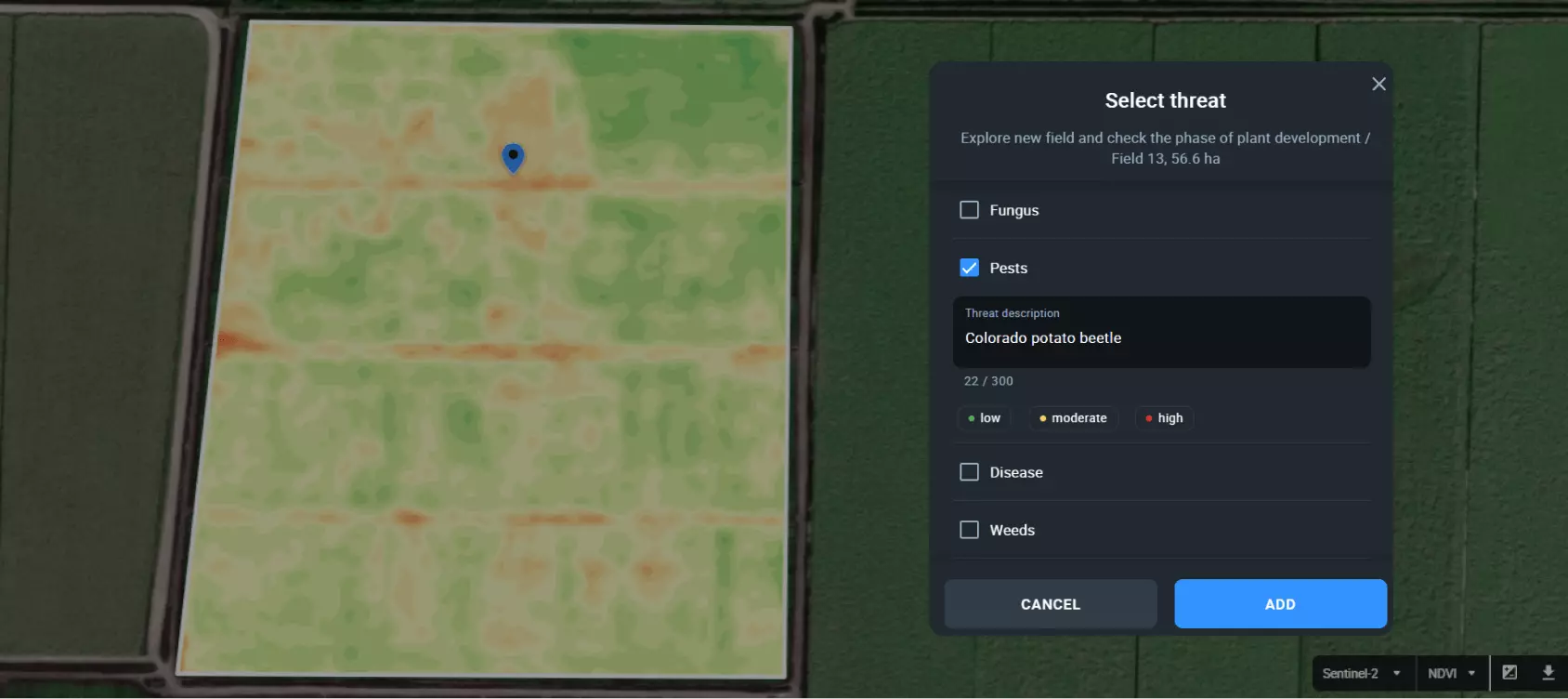
Since fertilizers and irrigation can’t make up for pest and disease damage, preventative measures are necessary. The Disease risk feature of EOSDA Crop Monitoring comes into play here. It allows you to detect threats early on in any potato growing field, no matter how extensive and remote. The calendar-like interface presents a clear overview of potential diseases categorized from low to high risk. This empowers agronomists to prioritize their efforts and plan preventive measures efficiently. Large-scale food producers can use satellite-derived analytics provided by the Disease risk feature of EOSDA Crop Monitoring to prevent the spread of diseases and maintain stable yields.
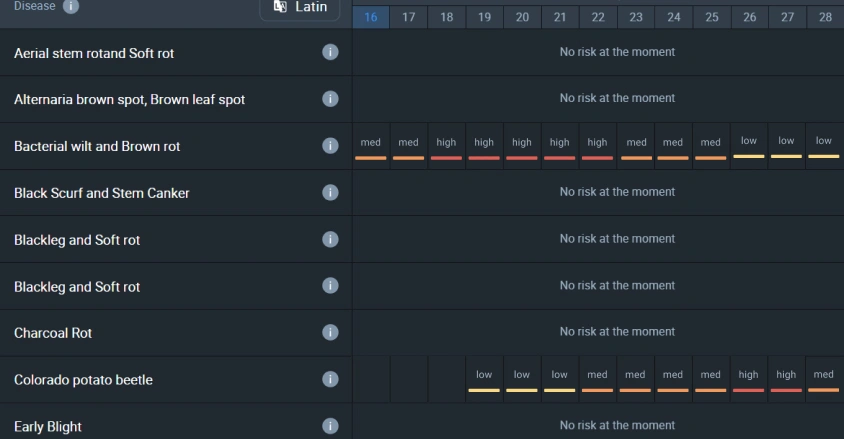
How Long Do Potatoes Take To Grow?
The typical time to grow potatoes is between 90 and 120 days for most cultivars. It takes roughly 60–80 days to grow early-season varieties, 80–100 days to grow mid-season varieties, and 100–130 days to grow late-season varieties. Which variety to cultivate will depend on how long the growing season in your region lasts.
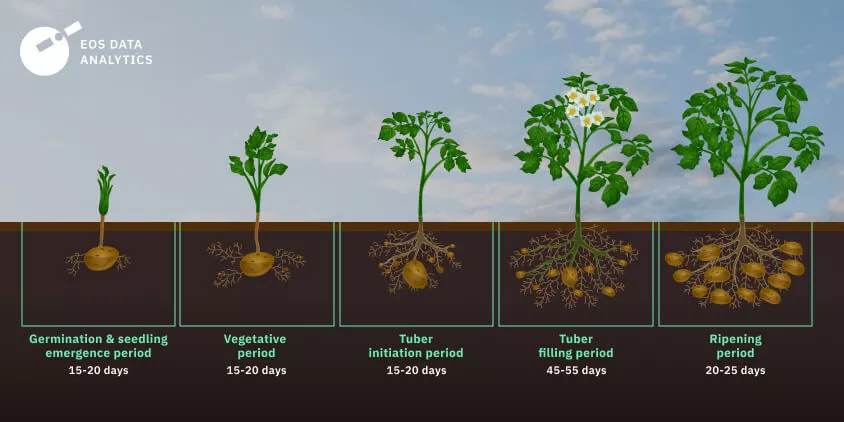
Potato Harvest Time And Techniques
To fully enjoy the fruits of your labor, it’s crucial to understand the optimal potato harvest timing and techniques. Gentle harvesting at the right time ensures that you get the best quality and storage potential from your crop.
When To Harvest Potatoes
You can tell it’s harvest time for potatoes by looking at their blossoms and foliage. Two to three weeks after plants have finished flowering, you can carefully dig out some baby potato tubers. Two to three weeks after the leaves have faded back, you can harvest mature tubers. Other indicators of ripeness are that the vine dies completely, the tuber skin sets, and the tubers grow to a desired size. Make sure to harvest tubers before a hard frost hits.
Harvesting Techniques
Vine killing (desiccation) is a common practice done before harvesting potatoes. Turning off irrigation, using mechanical means like rotary choppers, and/or spraying chemical topkillers are all prevalent ways for farmers to kill the plant vines. After the haulms have been killed, the tubers are often left in the ground for 10–14 days. This allows the potato skin to grow thicker, which protects the tubers from being bruised during transportation and means extending their shelf life and reducing the risk of contamination.
The crop is gathered with the help of modern tractor-mounted harvesting machines. These devices harvest potatoes by using oscillating shares to lift them from the ground. Finally, the tubers are placed on a set of webs to be cleaned of rocks, dirt, and other debris, getting ready for further processing.
Despite the challenges of growing high-quality potatoes on a large scale, commercial farmers have a bright prospect ahead of them. Focusing on crop needs and using the right methods and technologies lays the groundwork for plentiful yields that satisfy market demand.
About the author:
Vasyl Cherlinka is a Doctor of Biosciences specializing in pedology (soil science), with 30 years of experience in the field. He attended the engineering college in Ukraine and received his degree in agrochemistry, agronomy and soil science in the Chernivtsi National University. Since 2018, Dr. Cherlinka has been advising EOSDA on problems in soil science, agronomy, and agrochemistry.
Recent articles

Analyze 2025 & Plan Your Best Year Yet: LandViewer Christmas Offer
It’s the most wonderful time of the year! The Christmas holidays are here, and so is your chance to analyze 2025 and plan a prosperous 2026 with more affordable Pro plans in LandViewer.

EOSDA Models Climate Change Impact On Sugarcane Yields
EOSDA modeled future temperature, rainfall, and other climate impacts on Veracruz sugarcane. The results help growers plan long-term adaptation strategies, including timing, varieties, and irrigation.

EOSDA LandViewer Black Friday Sale: Exclusive Offers & Giveaway
This Black Friday, LandViewer offers new users the chance to save on monthly plans, get extra months with yearly subscriptions, and participate in a free annual plan giveaway.